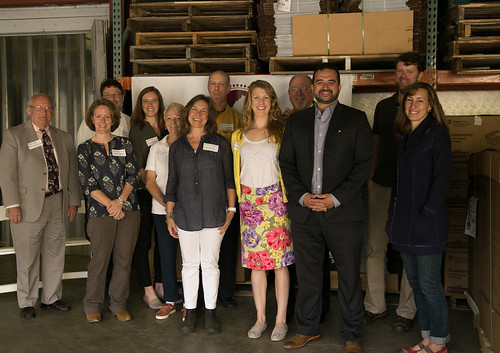
Results—at USDA we are constantly tracking and measuring them. We want to know that what we’re doing is making a difference, that we’re making progress towards our mission, that the communities we support are getting the help they need. Recently I had the pleasure of visiting local food stakeholders that are making a real difference in Charlottesville, VA and hear firsthand how USDA programs have made an impact in their community.
During my visit, I had a chance to listen to farmers, local food organizers, and business owners share their experiences involving local food production. Just outside Charlottesville, I toured the Hill Farm and the warehouse of Local Food Hub. The open dialog of these visits is important to me and important to USDA. I strongly believe that we need to hear from the public so we make sure our priorities, programs and services are in line with what the American people need.
“When Secretary Vilsack identified strengthening local food systems as one of the four pillars of USDA's commitment to rural economic development, it made a huge difference in how this community viewed local food,” said Kristen Suokko, Local Food Hub Executive Director.
She also expressed her appreciation of USDA’s open door policy and desire to build long lasting relationships with its stakeholders. Kristen shared how her local food business has benefited from USDA programs, such as the Farmers Market and Local Food Promotion Program, the Specialty Crop Block Grant Program and the Good Agricultural Practices (GAP) certification program, offered by the Marketing and Regulatory Mission Area and administered by the Agricultural Marketing Service.

The leadership at USDA realizes that even the most productive farmers can’t succeed if there is no way to get their products to market. That is why USDA has focused on expanding our investments to meet the needs of a diversifying agricultural industry. Since 2014, the USDA has made over 900 investments in local food infrastructure that include food hubs, warehouses, local processing facilities, and distribution networks connecting farmers with local markets. Local Food Hub in Charlottesville, VA is one of those investments.
Since 2009, Local Food Hub, a nonprofit organization, has partnered with Virginia farmers to increase access to local food. I heard firsthand how they provide the support services, infrastructure and market opportunities that connect people with food grown close to home. USDA investments in such innovative projects allows for more of the food dollars to stay in farmer’s pockets and improve consumer access to fresh and local food.
This visit was also an opportunity to share how, under this Administration, USDA has invested more than $1 billion in over 40,000 local and regional food businesses and infrastructure projects. I also talked about another fantastic resource, our recently-revamped website for Know Your Farmer, Know Your Food, which helps farmers and consumers discover our resources across USDA to support local and regional food systems. This website provides a useful one-stop shop that covers every point in the local food supply chain, including USDA grants, loans, and other instructional guides. Additionally, the KYF2 Compass maps over 4,200 federal investments in local and regional food systems across the country.
We also talked about the importance of connecting with consumers and growing markets. The USDA offers directories for community supported agriculture enterprises, food hubs, on-farm stores and farmers markets. I highlighted how our USDA’s Local Food Directories helps connect consumers to fresh food right in their community, including the National Farmers Market Directory - listing over 8,500 farmers markets nationwide. In fact, data from the National Farmers Market Directory indicates that the number of farmers markets nationwide has increased by 93.3 percent between 2006 and 2014. In my opinion, this is just another example of the robustness of the local and regional foods movement in our country.
Having open and direct conversations with stakeholders in the local food sector is key to accomplishing our common goals—supporting innovation and continued growth in the local food sector. The exchange of information for both local stakeholders and the leaders at USDA can go a long way to ensuring that we remain committed to a partnership, and committed to addressing the present and future challenges in agricultural production, and mapping out the path forward together.
More information on how USDA investments are connecting producers with consumers and expanding rural economic opportunities is available in Chapter IV of USDA Results on Medium.

